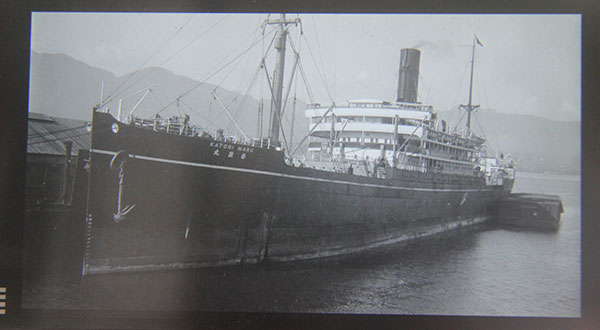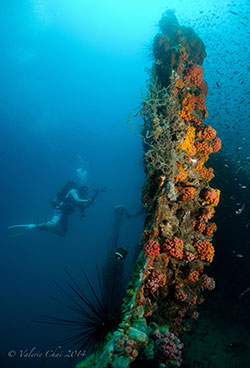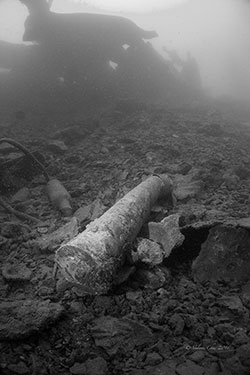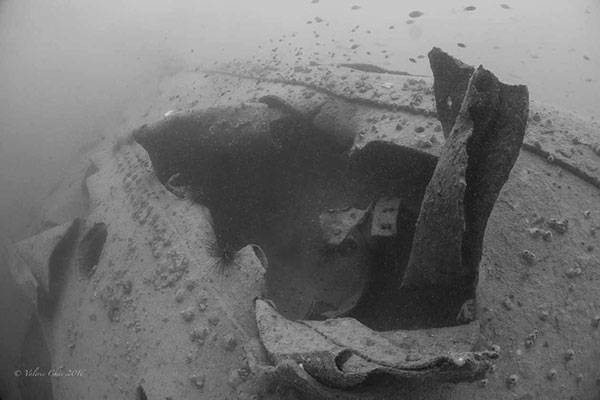
Fum shows a photo of the Katori Maru which he found on the internet on his phone.
FOR THOSE who had the opportunity to visit the World War Two (WWII) Japanese shipwreck Katori Maru and loved her beauty from up close – some even returning regularly every year to see how she has aged – the last few months have been filled with anxiety since the news first broke in early March of their beloved shipwreck being possibly targeted by metal salvagers.
Now, with photos confirming her undignified demise, her fate has been an especially bitter pill to swallow.
Those thesundaypost spoke with are reluctant to point fingers at anyone, but frustration and anger is bubbling over the seeming impunity enjoyed by the perpetrators who appear to have gotten away scot-free.
Divemaster Fum Tze Eng has been taking people to dive at the wreck just off the coast of Santubong for at least 10 years.
One reason why it attracted people from all over the country and the world was due to its relative ease of accessibility even for beginner divers, and the diversity of marine life which turned the wreck into a underwater museum and natural playground.
Now, all that remains – at least, the still recognisable parts of it – is a small section of the shipwreck’s bow where its name is written, he told thesundaypost.

A diver prepares to photograph a colourful wall of coral which adorn one of the metal structures of the Katori Maru in this photo taken in 2014.
Beautifully preserved
According to information available on http://www.wrecksite.eu/ – a website which tracks and keeps records of shipwrecks worldwide – the Katori Maru was originally a passenger or cargo ship built in 1913, measuring 149.4m x18.6m x 11m. It is likely she was used to ferry Japanese troops or cargo during WWII. She was hit by Dutch submarine torpedoes on Dec 23, 1941 at 22:40 hrs as she was on her way to Kuching and sunk just a few hours later shortly after midnight.
She was one of three WWII Japanese shipwrecks which has so far been identified in the state. The other two shipwrecks are the Hiyoshi Maru and the destroyer Sagiri.
Before the rogue salvagers did their worst, the wreck of the Katori Maru was a magnificent sight to behold, divers say. Despite the damage by torpedoes, many of its visible features and the cargo in the depths of its hull had remained intact and undisturbed for the better part of 75 years underwater.
Shell casings and mortars, a giant anchor, tiled bathrooms, and even a coral encrusted sitting toilet served as silent reminders on how time for the Katori Maru had stopped when it sunk to the seabed.
However, man’s loss was nature’s gain. The sea claimed the shipwreck as one of its own and over time, turned it into a home for a colourful cast of coral, fish, turtles, box jelly fish and even whale sharks.
“I feel that we have lost a beautiful dive spot. It is so near Kuching and every year we go. Next year, we don’t know what we will see,” diver Valerie Chai said wistfully as she showed thesundaypost photos she had taken of the wreck over the years and contrasted it with what she called ‘heartbreaking’ photos she had taken during her most recent dive that showed the aftermath of the rogue salvagers.
Killed potential
Tour operator and diving business owner Edward Yong expressed his regret that the Katori Maru was destroyed just at the start of the diving season and more so, just as its star as a popular diving site for locals and tourists was ascending. There are very few diving sites in Malaysia which could rival its unique characteristics and favourable qualities such as easy accessibility and location, he said.
He likened the actions of the salvagers as to killing the golden goose just as it was about to lay the golden egg.
“It has become a yearly event to visit this wreck. All my new divers have been waiting since the beginning of this year. This is the best time to dive – the month of May when you have very good visibility and you can see at least half the ship.
“We have people coming in from West Malaysia and Sabah to dive because it is getting more popular. We even have the Japanese coming in just for the wreck. And now they will ask, how come nothing has been done? How are we going to answer them?” he said, sharing his frustrations.
Yong sees little value in arguing as to who should take responsibility for the destruction of the Katori Maru. Instead, he wants to know how matters will move forward in view of protecting and conserving other sites and structures with historical or cultural value, both on land and under the sea, whether natural or man-made.
“We have very, very beautiful caves with historical value but we cannot conserve it as they are gazetted to be blown up. What will be next? Could the Courthouse be next because someone wants to turn it into a supermarket? Who is going to conserve all this? Is it not important? You want to promote tourism, but what is left to promote when all your historical things are destroyed?” he pointed out.

A single bombshell sits on the debris-covered seabed, surrounded by mangled metal.
Unanswered questions
Unfortunately, it is too late now for the Katori Maru.
Yong and Fum suspect that another WWII Japanese shipwreck – known amongst the local divers and fishermen as the ‘Barge’ – located about 6 nautical miles away from the Katori Maru had already fallen victim to metal salvagers earlier this year.
Any action taken by the authorities now cannot undo the damage that has already been done and will seem like a case of shutting the barn doors after the horses have fled.
However, although the value and reputation of the Katori Maru site as a underwater tourism and diving attraction has been significantly damaged, the site is still vulnerable to other rogue metal salvagers and opportunistic parties in search of historical artifacts and antiques.
The salvager’s claw had violently ripped open the Katori Maru’s hull as it pulled parts to the sea’s surface, spilling out the contents once contained in its belly such as porcelain plates and bowls. What should be done to prevent further damage and protect what’s left? Should anything be done at all?
It also raises the question of how protected are the other historical shipwrecks and marine sites which have been identified. Unfortunately, not very much.
Murky waters
Frustration over the fate of the Katori Maru are shared by a number of those within the government. They say they have been held back by the lack of legislation governing marine sites with historical and cultural significance, which includes shipwrecks.
Presently, only the Sarawak Rivers Ordinance 1993 has provisions pertaining to historical and cultural artifacts found underwater, but its scope is limited to rivers and foreshores. The ordinance states that any antiquity and treasure trove found on the bed or beneath any river or foreshore shall be the property of the government and that the said antiquity and treasure trove shall be dealt with in accordance with Part II of the Sarawak Cultural Heritage Ordinance 1993. It also clearly states that the removal of such antiquities and treasure trove requires a valid permit from the Controller of Rivers.
thesundaypost has learnt that discussions to amend the Sarawak Cultural Heritage Ordinance 1993 to extend to include underwater cultural heritage sites have been underway over the last few years.
However, progress to get the shipwrecks protected have been painstakingly slow.
Part of the difficulty stems from the fact that the protection and monitoring of Malaysian waters and marine sites fall under the jurisdiction of multiple government agencies, including the Marine Department of Malaysia, Malaysian Maritime Enforcement Agency (MMEA) and the Royal Malaysian Navy.
How far a site is from shore and the nature of events unfolding taking place at said site will determine which agencies will take charge.
In Sarawak, it may also necessitate the involvement of state agencies and bodies such as the Ministry of Tourism, Arts and Culture, Sarawak Museum Department, the Sarawak Rivers Board, and Forest Department of Sarawak, depending on the location and historical and cultural significance of the site.
With so many agencies in the mix, it has only amplified the potential for communication missteps and unnecessary red tape, already exacerbated by the lack of legislation to guide and coordinate these agencies as well as give them substantial resources and powers for monitoring sites, implementing operations, prosecuting perpetrators and enforcing the law.
In the case of the Katori Maru, the rogue metal salvagers had a permit from the Marine Department to salvage metal but they did not have permission to salvage the wreck which was located far away from the area they were given the permit for. The lack of proper provisions pertaining to the protection of the shipwreck site means the metal salvagers could not be charged by the authorities, MMEA Sarawak chief First Admiral Ismaili Bujang Pit had recently told The Borneo Post.
One small comfort arising from the tragic fate of the Katori Maru is that it will revive and add much needed and welcomed urgency to efforts to get marine sites of historical and cultural value protected.
However without sustained political will, it is likely that the future of these historical shipwrecks will continue to remain murky.
Preserving the memory
Meanwhile, Yong suggested that perhaps the authorities such as the state Museum Department could look into preserving what remains of the shipwreck, including rescuing items from it and setting up an exhibit in memory of the Katori Maru. This may include historical and recent photos of the ship, and a timeline explaining its role and significance within the context of WWII, he said.
“I believe that such an exhibit will be beneficial to everyone, and attract tourists to come, even if they can’t visit the wreck itself,” Yong added.
He is in favour of providing amnesty to individuals who had taken away artifacts from the shipwreck who willingly donate these items to the museum. He argued that not everyone who had taken artifacts should be branded as thieves or treasure hunters as these items do not have much monetary value, and that people might have taken them because they appreciated them.
Fum agreed with the idea of setting up a museum exhibit or some kind of memorial, saying that individuals such as himself would be willing to donate photos and other items so that the memory of the Katori Maru could be preserved and her story told to visitors and future generations.

The salvager’s claws left deep gashes on what it could not pick up. — Photos by Valerie Chai
